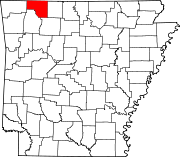Carrollton, Arkansas
Carrollton, Arkansas | |
|---|---|
| Coordinates: 36°15′45″N 93°19′19″W / 36.26250°N 93.32194°WCoordinates: 36°15′45″N 93°19′19″W / 36.26250°N 93.32194°W | |
| Country | United States |
| State | Arkansas |
| County | Carroll |
| Time zone | UTC-6 (Central (CST)) |
| • Summer (DST) | UTC-5 (CDT) |
| ZIP code | 72611 |
| Area code(s) | 870 |
| GNIS feature ID | 57516 |
Carrollton is an unincorporated community in Carroll County, Arkansas, United States. Once a thriving community with a population near the 10,000 mark in the 1850s, there are generally 30 residents now in the unincorporated community with a historically significant past.
Geography[]
Carrollton is located at 36°15′45.25″N 93°19′18.66″W / 36.2625694°N 93.3218500°W (36.2625706, -93.3218492).[1]
Only Highway[]
 U.S. Highway 412
U.S. Highway 412
History[]
Carrollton was settled circa 1840 and was named for Charles Carroll, a signatory of the U.S. Declaration of Independence. By the time of the American Civil War in 1860, Carrollton had grown to a population of 6,000. The town supported six hotels and three livery stables.
In the center of the town was a basin fed by a 3/4-mile-long flume built from cedar, which was fed from a stream higher up a neighboring mountain.
A Civil War skirmish lead by Confederate soldier Joe Cumia was fought there, and a historic marker now marks the site.
Carrollton was the county seat of Carroll County before the area was split into two counties, Carroll and Boone. The new county seat of Carroll County was split between Berryville and Eureka Springs. Wilson Springs (now Harrison) became the seat of county government for Boone County. Records for both counties were stored in Carrollton. Rather than wait for the records to be separated, a group of men from Wilson Springs came in the dead of night in the mid 1870s, breaking into and carting off the county records.
Today, little remains of the original town.
References[]
- ^ "US Gazetteer files: 2010, 2000, and 1990". United States Census Bureau. 2011-02-12. Retrieved 2011-04-23.
- Former county seats in Arkansas
- Populated places established in 1840
- Unincorporated communities in Arkansas
- Unincorporated communities in Carroll County, Arkansas

